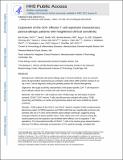Expansion of the CD4+ effector T-cell repertoire characterizes peanut-allergic patients with heightened clinical sensitivity
Author(s)
Ruiter, Bert; Smith, Neal P; Monian, Brinda; Tu, Ang A; Fleming, Elizabeth; Virkud, Yamini V; Patil, Sarita U; Whittaker, Charles A; Love, J Christopher; Shreffler, Wayne G; ... Show more Show less
DownloadAccepted version (1.312Mb)
Publisher with Creative Commons License
Publisher with Creative Commons License
Creative Commons Attribution
Terms of use
Metadata
Show full item recordAbstract
© 2019 American Academy of Allergy, Asthma & Immunology Background: Individuals with peanut allergy range in clinical sensitivity: some can consume grams of peanut before experiencing any symptoms, whereas others suffer systemic reactions to 10 mg or less. Current diagnostic testing only partially predicts this clinical heterogeneity. Objective: We sought to identify characteristics of the peanut-specific CD4+ T-cell response in peanut-allergic patients that correlate with high clinical sensitivity. Methods: We studied the T-cell receptor β-chain (TCRβ) usage and phenotypes of peanut-activated, CD154+ CD4+ memory T cells using fluorescence-activated cell sorting, TCRβ sequencing, and RNA-Seq, in reactive and hyporeactive patients who were stratified by clinical sensitivity. Results: TCRβ analysis of the CD154+ and CD154− fractions revealed more than 6000 complementarity determining region 3 sequences and motifs that were significantly enriched in the activated cells and 17% of the sequences were shared between peanut-allergic individuals, suggesting strong convergent selection of peanut-specific clones. These clones were more numerous among the reactive patients, and this expansion was identified within effector, but not regulatory T-cell populations. The transcriptional profile of CD154+ T cells in the reactive group skewed toward a polarized TH2 effector phenotype, and expression of TH2 cytokines strongly correlated with peanut-specific IgE levels. There were, however, also non–TH2-related differences in phenotype. Furthermore, the ratio of peanut-specific clones in the effector versus regulatory T-cell compartment, which distinguished the clinical groups, was independent of specific IgE concentration. Conclusions: Expansion of the peanut-specific effector T-cell repertoire is correlated with clinical sensitivity, and this observation may be useful to inform our assessment of disease phenotype and to monitor disease longitudinally.
Date issued
2020Department
Koch Institute for Integrative Cancer Research at MITJournal
Journal of Allergy and Clinical Immunology
Publisher
Elsevier BV